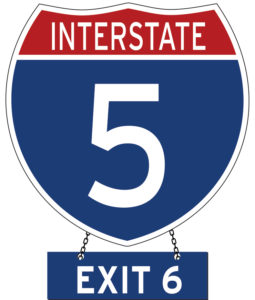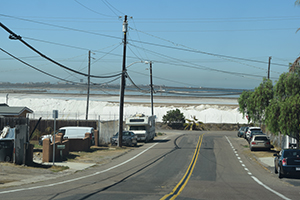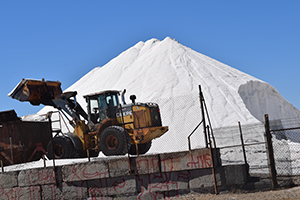Exit 6 (Palomar Street): South Bay Salt Works
Klauber-Wangenheim, a Jewish Firm, Produced Salt When It Was Needed to Preserve Meat

 From Palomar Street exit, go west to Bay Boulevard and turn left to the south. The South Bay Salt Works may be viewed through a fence on the right.
From Palomar Street exit, go west to Bay Boulevard and turn left to the south. The South Bay Salt Works may be viewed through a fence on the right.
There are no public tours of the South Bay Salt Works, which is leased from the United States Fish and Wildlife Service. The Salt Works are a residual portion of what once had been the privately owned 19th Century La Punta Salt Works and the 20th Century Western Salt Company. Under management of the Fish and Wildlife Service, many of the previously existing evaporation ponds have been restored as wetlands, providing nesting areas for migratory birds and natural nurseries for fish.

Even with the major portion of the old saltworks being repurposed, one still can see how salt is processed from sea water. A three-step process occurs within shallow ponds with levees around them. In the first pond, seawater evaporates to the point that it becomes brine. That is moved to a second shallow pond for further evaporation, and finally into a third pond where the salt crystallizes. From here the salt is dredged out of the pond and made into salt mounds, which quickly crust over, protecting the salt inside the mounds.

In 1901, the area’s largest wholesale grocery and dry goods concern, the Klauber-Wagenheim Company, purchased La Punta Salt Works in response to the rising price of salt. That company began business in 1869 under the partnership of two Jewish merchants, Abraham Klauber and Samuel Steiner. In addition to salt, it sold to outlying retail stores such products as groceries, liquors, tobacco, cigars, dry goods, clothing, boots, shoes, hardware, and farming implements. According to The Journal of San Diego History (July 1959 issue), “all accounts were payable in ‘U.S. gold coin’ and interest was charged at the rate of 2 percent per month on overdue accounts.”
Abraham Klauber was succeeded in the business by his sons Melville and Edgar Klauber, while Steiner eventually was replaced as a partner by Abraham’s son-in-law Julius Wangenheim and his brother-in-law Henry Epstein. Simon Levi, who would go on to found his own firm, was another partner. After a while, the business became known as Klauber-Wangenheim Co.
The venture into the salt business was short lived. Klauber-Wangenheim found it more profitable to purchase such quantities of salt as needed by their customers, rather than running a separate operation. So, in 1902, they sold the business to pioneer developer Elisha Babcock, who perhaps had been best known as the developer of the Hotel del Coronado. Babcock turned the business over to his son Graham, and the company was renamed as the Western Salt Company.
The market for salt was different in those days than it is now, because prior to refrigeration salt was used almost universally to preserve foods. When that method became mostly obsolete, salt manufacturers developed other markets, including water softening and snow removal from roads. The Western Salt Company continued to prosper even under changing market conditions. A narrow-gauge railroad was installed to carry salt from one portion of the salt works to another, and the spot where that railroad crossed the standard-gauge San Diego and Arizona Railway was so noteworthy, it was preserved even after the rest of the narrow-gauge railroad was destroyed.
Julius Wangenheim, who had married Laura Klauber, played an important role in San Diego’s development. He was instrumental in building the San Diego Library early in the 20th century and went on to serve as a member of the committee that planned the Panama-California Exposition in 1915 at the newly named Balboa Park. In his role as President of the Bank of Commerce, he served as a member and treasurer of the Marine Biological Association of San Diego and purchased the land on which Scripps Institution of Biological Research (now the Scripps Institution of Oceanography) was constructed. He also was instrumental in bringing about the merger between Scripps and the University of California-San Diego (UCSD).
Wangenheim also was a founder of the San Diego Museum of Art in Balboa Park.
*
Next Sunday, March 6, 2022: Exit 7A (L Street): Southwestern College
*
This story is copyrighted (c) 2022 by Donald H. Harrison, editor emeritus of San Diego Jewish World. He may be contacted via donald.harrison@sdjewishworld.com